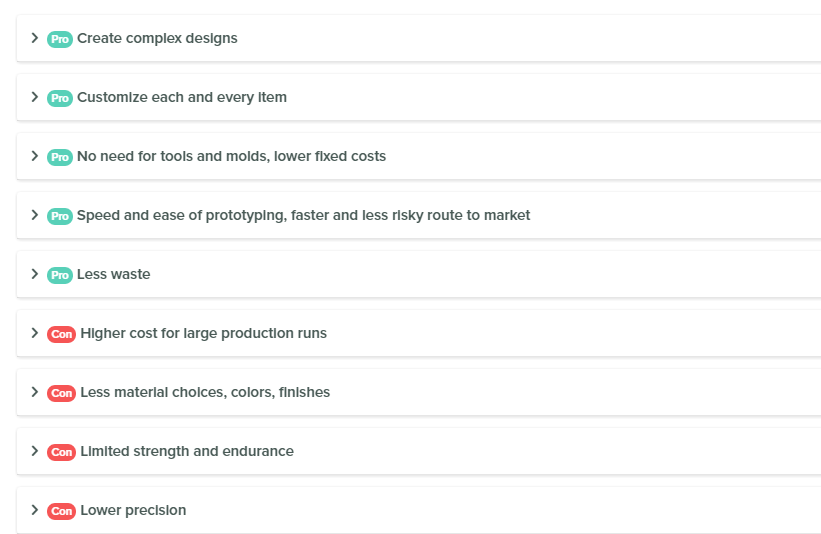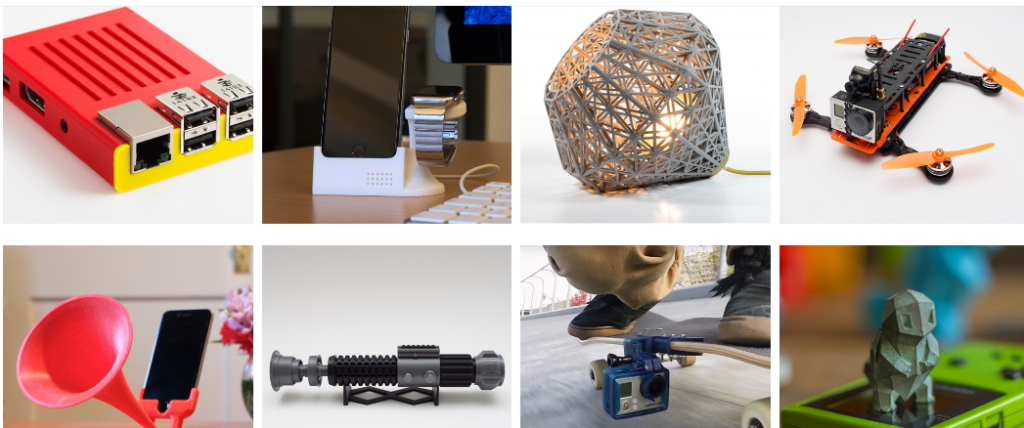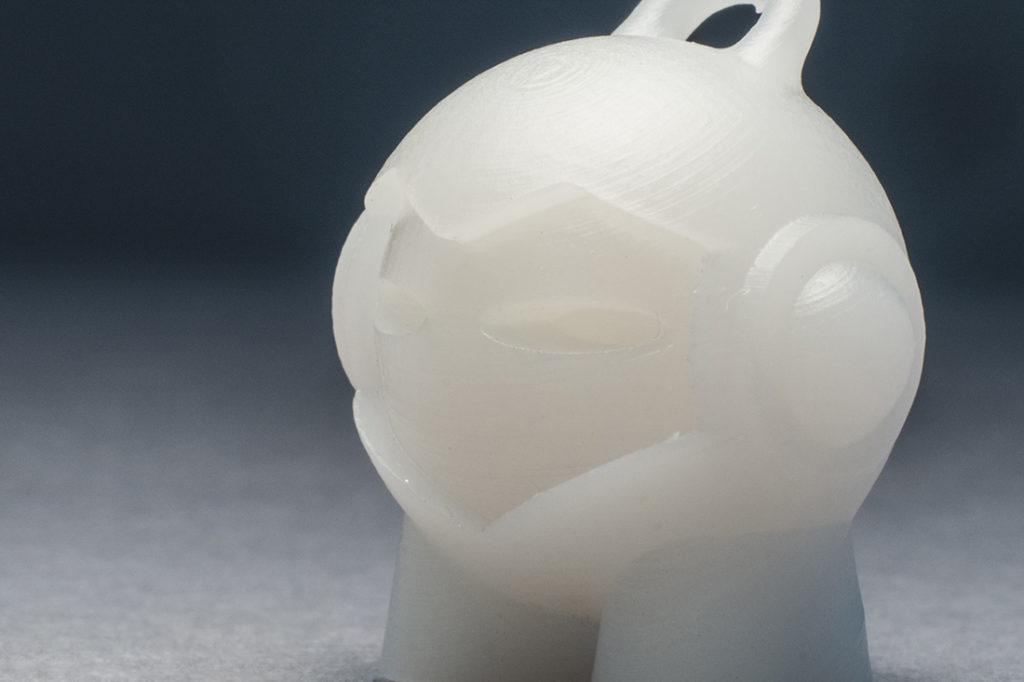It’s no secret that I’m a big fan of 3D Hubs and all of their reports. Always well thought out and entertaining, I mainly look forward to seeing their data reports on monthly industry trends which truly offer a continual education. Taking that one massive step further for users around the world, now they’ve released The Definitive Guide to 3D Printing.
3D Hubs starts by asking quite simply, “What is 3D printing?” This answer has now been given quite comprehensively, and notably with the help of many detailed suggestions from their 30,000 3D network hubs around the world. And if you are like most makers, you realize that considering the relative novelty of the technology and all that accompanies it, there is always still plenty to learn—no matter your level of expertise. As with all 3D Hubs information, the guide comes along in ‘easily digestible’ format with great images and videos, and we’ve boiled it down to some of the basic points for you, while the actual Definitive Guide to 3D Printing can be found here.
The basics are described for newcomers, as well as a brief history on 3D printing and the first 3D printer via Chuck Hull—and let’s make a note here that he and his first SLA printer (the SLA-1) were just recently honored at 3DS Headquarters with the machine itself being designated a Historic Mechanical Engineering Landmark by the American Society of Mechanical Engineers (ASME).
As 3D Hubs points out, in 1983 Hull was indeed responsible for creating the foundation for the magical technology we know today. And with numerous original patents beginning to expire for 3D printing, a veritable explosion has happened in the marketplace, with 3D printing going from mainly industrial use to now also offering a huge desktop platform, very much springing from the RepRap project—with a long list of manufacturers following after them.
“There are now roughly 300,000 consumer 3D printers in the world – and this figure is doubling every year,” states 3D Hubs.
They also list the pros and cons succinctly, and cause the maker on any level to ponder whether they need to 3D print everything—or are some things being fabricated just because, well, they can be? The list also makes for a compelling argument about why the new technology is often so much superior to traditional processes which take longer, cost more, and don’t allow for the same level of self-sustainability on numerous levels.
And if you’re wondering exactly who is most engaged in using this technology, 3D Hubs takes this opportunity to school us in regards to every sector benefitting from 3D printing. For example, did you know that almost all of today’s hearing aids are 3D printed? Chalk one up for medical. Or how about that SpaceX SuperDraco engine that we’ve reported on so much? Thanks to 3D printing with metal, using a special alloy called Inconel, the engine chambers were made in record time. And that’s just the tip of the iceberg in what’s happening in the aerospace and aeronautics industry.
There’s a whole new world of innovation open to architects, designers, engineers, from the home desktop to the office—not to mention what the technology has done for those interested in model making—and more specifically, drones. 3D Hubs passes along words from industrial designer Ken Giang, who 3D printed drones as a hobby in his free time:
“One of the benefits of using 3D printing is that I can produce unlimited spare parts without relying on external vendors except for the electronics,” he explains. “Furthermore, I can develop and customize my multi-copter designs around my particular needs. This motivates me to keep designing parts and be creative to develop new and better concepts.”
And what about items like the 3D printed pilotless plane/drone just released by Airbus? Or the Captor UAS 3D printed fixed-wing drone just coming to market? Students, product and prop designers, shoe manufacturers, consumer product makers, and many others are now being offered infinite options for creating with the technology of 3D printing before them.
The following 3D printing techniques are given an overview as well:
- FDM – fused deposition modeling is most commonly used, featuring the now traditional layering technique. It is also viewed as the most affordable mode of 3D printing.
- SLA and DLP – for stereolithography (SLA) and digital light processing (DLP), both of these 3D printing processes use resin for building 3D models which are then cured or made solid by a light source. SLA uses a laser; DLP employs a projector for curing.
- SLS – a laser is used to melt and cure powdered material, layer after layer.
- Binder jetting – for industrial uses, sandstone is most often used here. More affordable than SLS, the results are often not as durable. It’s popular for architectural models and sculptures.
- Material jetting (polyJet and multijet modeling) – for industrial uses, this process works by jetting layers of liquid photopolymer onto a build tray, where they are then cured with UV light.
“Material Jetting offers many advantages for rapid tooling and prototyping, as it allows users to create realistic and functional prototypes with fine details and precision,” states 3D Hubs. “These are the most precise 3D printing technologies today, printing with up to 16-micron (that’s thinner than a human hair) layers.”
The next conversation is one that has, over the past few years, become vast: materials. What to print and what to print with? Decision, decisions—and lots of fun and experimenting to be had. From plastics to resins to metal, the options abound. 3D Hubs recommends your general plastics such as ABS or PLA for basic prototyping, toys, and scale models. Nylons are recommended for more functional and complex designs, while materials like sandstone are meant for more non-functional objects like sculptures, models, and gifts.
Metal 3D printing, of course, is all the rage industrially, making use of metal powders such as aluminum, cobalt chromium, bronze, and even titanium—a material that we report on often for its uses in so many 3D printed items, from mountain bike frames to a growing number of FDA approved 3D printed medical implants. When trying to decide exactly what it is you want to print with, 3D Hubs suggests using their guide and comparing materials side by side (they have handy pop-outs describing everything from rigid opaque plastic to high-detail resin).
And if you happen to just be getting started, the first step is a no brainer: get ye to a 3D printer!
After that, you’ll have to figure out what type of 3D models you want to print out first. Will you be downloading something fun from a popular 3D repository like Thingiverse, or do you want to start learning digital design?
“3D models are created using computer-aided design (CAD) tools, various specialized software tools that simplify the design process on computers, tablets or even smartphones,” explains the 3D Hubs team.
They also recommend a long list of design options, from Sketchup for beginner and intermediate levels to Solidworks or AutoCAD for the professionals. There is always the option also of working with a 3D printing service bureau that will set you up with a designer who can help you achieve the concept you are working on.
Keep in mind of course that 3D Hubs is in the business of providing you with 3D printing services, so if you aren’t in the market for buying and maintaining a 3D printer, it’s very easy to have your model printed by one of their HUBS.
“With 3D Hubs, there’s no need to own a 3D printer. We connect you with local people and businesses (our Hubs) that run their own 3D printers and have experience printing,” says 3D Hubs.
“Getting started is easy: simply upload your 3D model and search for Hubs in your city or neighborhood. We automatically calculate pricing and help you throughout the entire order process.”
Whether you are printing a simple fun model or need something produced on an industrial printer, they have over 30,000 Hubs around the world; not only that, when you go through 3D Hubs you are supporting a local business near you.
And saving some of the best for last, this guide from 3D Hubs offers some great tips you’ll want to bookmark for good.
Are you wondering how you’ll know if your model is printable? If you are using the 3D Hubs service, the great thing is that they will check your file when you upload it, automatically searching for any holes in the mesh.
“This initial check is to ensure that your model is a so-called solid mesh – a model where all the edges of the polygons that build up the model are connected to one-another (manifold geometry),” says 3D Hubs.
They offer advice on preparing your file for printing and exporting, as well as dealing with thickness:
“When designing your part in 3D space, it can be easy to forget about the laws of nature. Always make sure that everything has a volume and your model doesn’t have any surfaces with zero thickness. Even though layers can be printed as thin as 0.016 mm with some technologies, such thin feature would break as soon as you touch it,” says the 3D Hubs team.
They also offer guidance regarding dimensions and what to do if you have a larger volume model:
“In case you can’t find any printer that’s capable of printing your model, we suggest two solutions: either scale down your model, or break it up into several parts that can be assembled after you have printed them.”
And when it comes to scaling your models, 3D Hubs recommends using Netfabb. That of course, is up to you, but 3D Hubs does mention that there you will find it quite easy to scale, save, export, and upload your files. You can also use Netfabb if you want to break your model into pieces (digitally, of course!).
You’ll also find great information on how to choose a printer and the accompanying settings:
- Layer height – with thinner height, you will undoubtedly see finer detail in your 3D print. This does, however, slow down speed and also means more cost in materials.
- Settings and materials for finely detailed prints: If the print has less than 2mm details or has large/multiple parts hanging over a 45° angle, the 3D Hubs team recommends using SLA or PolyJet technology; for complex prints that have intricate features, try SLS for the best outcome due to its powder base and lack of need for supports.
- Supportive geometry: You will most likely need to deal with using supports if your design has parts hanging over a 45° angle. That adds more effort and cost, as well as post-processing work on your part and is to be avoided when possible.
If material costs are a concern, 3D Hubs recommends watching their tutorial for tips on how to scale things down and then save money.
“Remember, we’re thinking in 3D. A 10×10×10 item is in fact double the volume of an 8×8×8 item, hence even a small reduction in the size of you model can reduce the price of your 3D print to a fraction of the original.”
You’ll also find great information on hollowing out your model, which is recommended through the use of Meshmixer, which you can download free and easily manipulate by following simple instructions for hollowing and saving your model, and then exporting. Just remember that the amount of reduction you see will completely depend on your model and the particular settings you choose.
“As you can see a few minutes of editing can save you a lot when it comes to 3D printing,” reminds the 3D Hubs team.
And taking the time to read their guide offers you an education, as well as a bit of a refresher course, that shouldn’t be missed. See 3D Hubs to find a printer near you—and don’t forget to check out their calendar for their special 3D printing events happening all over the world! Discuss this guide further in the 3D Hubs Definitive Guide to 3D Printing forum over at 3DPB.com.
Subscribe to Our Email Newsletter
Stay up-to-date on all the latest news from the 3D printing industry and receive information and offers from third party vendors.
You May Also Like
Gorilla Sports GE’s First 3D Printed Titanium Cast
How do you help a gorilla with a broken arm? Sounds like the start of a bad joke a zookeeper might tell, but it’s an actual dilemma recently faced by...
Nylon 3D Printed Parts Made More Functional with Coatings & Colors
Parts 3D printed from polyamide (PA, Nylon) 12 using powder bed fusion (PBF) are a mainstay in the additive manufacturing (AM) industry. While post-finishing processes have improved the porosity of...
$25M to Back Sintavia’s Largest Expansion of Metal 3D Printing Capacity Since 2019
Sintavia, the digital manufacturing company specializing in mission-critical parts for strategic sectors, announced a $25 million investment to increase its production capacity, the largest expansion to its operations since 2019....
Velo3D Initiates Public Offering in a Bid to Strengthen Financial Foundations and Drive Future Growth
Velo3D (NYSE: VLD) has been among a number of publicly traded 3D printing firms that have attempted to weather the current macroeconomic climate. After posting a challenging financial report for 2023,...






































